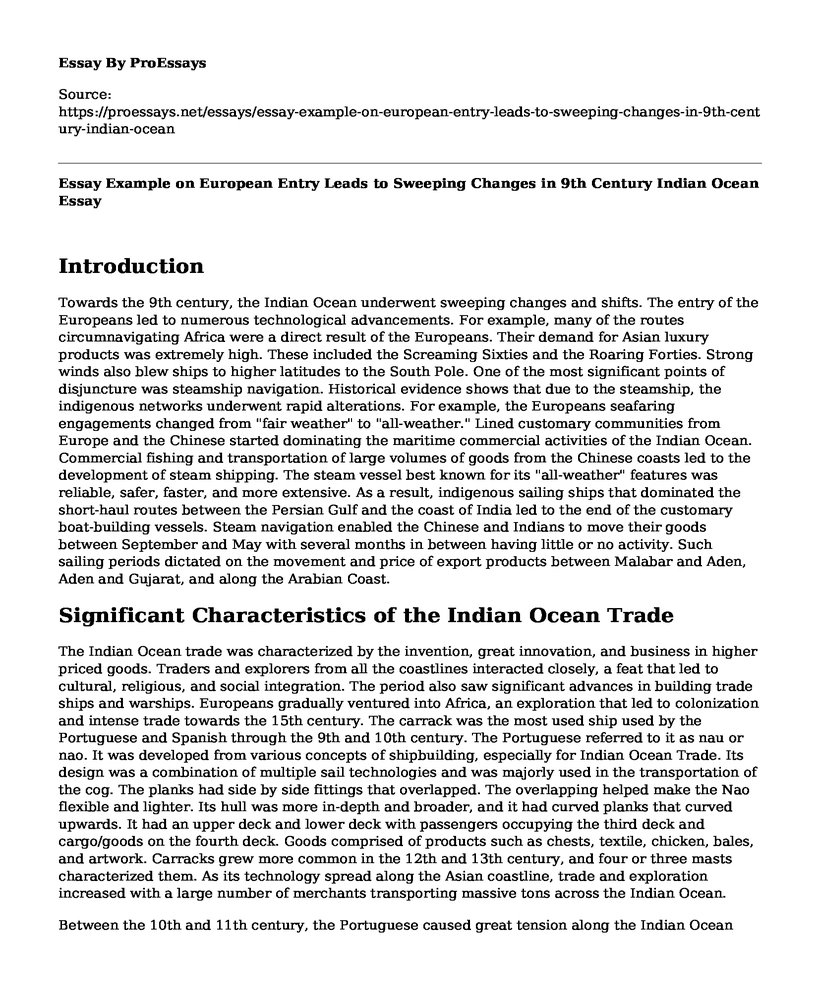Introduction
Towards the 9th century, the Indian Ocean underwent sweeping changes and shifts. The entry of the Europeans led to numerous technological advancements. For example, many of the routes circumnavigating Africa were a direct result of the Europeans. Their demand for Asian luxury products was extremely high. These included the Screaming Sixties and the Roaring Forties. Strong winds also blew ships to higher latitudes to the South Pole. One of the most significant points of disjuncture was steamship navigation. Historical evidence shows that due to the steamship, the indigenous networks underwent rapid alterations. For example, the Europeans seafaring engagements changed from "fair weather" to "all-weather." Lined customary communities from Europe and the Chinese started dominating the maritime commercial activities of the Indian Ocean. Commercial fishing and transportation of large volumes of goods from the Chinese coasts led to the development of steam shipping. The steam vessel best known for its "all-weather" features was reliable, safer, faster, and more extensive. As a result, indigenous sailing ships that dominated the short-haul routes between the Persian Gulf and the coast of India led to the end of the customary boat-building vessels. Steam navigation enabled the Chinese and Indians to move their goods between September and May with several months in between having little or no activity. Such sailing periods dictated on the movement and price of export products between Malabar and Aden, Aden and Gujarat, and along the Arabian Coast.
Significant Characteristics of the Indian Ocean Trade
The Indian Ocean trade was characterized by the invention, great innovation, and business in higher priced goods. Traders and explorers from all the coastlines interacted closely, a feat that led to cultural, religious, and social integration. The period also saw significant advances in building trade ships and warships. Europeans gradually ventured into Africa, an exploration that led to colonization and intense trade towards the 15th century. The carrack was the most used ship used by the Portuguese and Spanish through the 9th and 10th century. The Portuguese referred to it as nau or nao. It was developed from various concepts of shipbuilding, especially for Indian Ocean Trade. Its design was a combination of multiple sail technologies and was majorly used in the transportation of the cog. The planks had side by side fittings that overlapped. The overlapping helped make the Nao flexible and lighter. Its hull was more in-depth and broader, and it had curved planks that curved upwards. It had an upper deck and lower deck with passengers occupying the third deck and cargo/goods on the fourth deck. Goods comprised of products such as chests, textile, chicken, bales, and artwork. Carracks grew more common in the 12th and 13th century, and four or three masts characterized them. As its technology spread along the Asian coastline, trade and exploration increased with a large number of merchants transporting massive tons across the Indian Ocean.
Between the 10th and 11th century, the Portuguese caused great tension along the Indian Ocean coastlines that included ports such as Calicut, Kilwa, and Mombasa in Africa. They entered the Indian Ocean trade as pirates instead of trades. They initially started robbing Muslims of their valuable products. They considered Muslims as enemies and plundered their trading ships. The Portuguese tried to take control of the ports by attacking ships lacking Portuguese government permit. However, their control attempt was thwarted by the entry of European powers. The Ottoman navy strongly resisted their control attempts. The Indian Ocean was too vast, extensive, and faraway to hold any sway and control.
As music, culture, civilization, food, dance, and dress spread across and along the coastline, the neighboring regions experienced beneficial and peaceful cooperation. The Indian Ocean was thus viewed as a catalyst in advancing human collaboration, engagement, and socialization. Despite incidences that saw Muslims fighting the Portuguese and Hindu trying to expel the Muslim from their coastline, activity between Asia and the south coast of Africa went on smoothly. Into the 15th century, activities increased slowly with infiltration of explorers and missionaries from Europe.
Conclusion
The Indian Ocean trade became a dynamic trade marketplace that saw increased interaction of various cultures, civilization, and people. From Mombasa to East of Zanzibar, all the way to Java significant states and cities in India and Asia, explorers, missionaries, and traders interacted at a high intense rate. Fleets crossed major ports with travelers and traders exchanging valuable goods along the way. The trade inspired major explorers to venture out in the waters, expeditions that led to the Age of Discovery. The trade was characterized by significant voyages, discoveries, and establishment of substantial Empires, especially in China. Attempts to control the trade, especially by the Portuguese, resulted in increased innovation, especially of ships, cannons, and powerful carracks. The European's and Muslims demand for luxury goods increased the pace of trade as traders intensified their activities along the coastlines of the Indian Ocean. The Indian Ocean trade led to concerted efforts by Empires and Kingdoms to establish strategies to benefit from the social, commercial, and cultural exchange that took place along the Indian Ocean coastlines.
Bibliography
Bentley, Jerry H., Herbert F. Ziegler, and Heather Streets-Salter. Traditions and Encounters: a Brief Global History. 4th edition (New York: McGraw-Hill, 2016).
Cite this page
Essay Example on European Entry Leads to Sweeping Changes in 9th Century Indian Ocean. (2023, Feb 09). Retrieved from https://proessays.net/essays/essay-example-on-european-entry-leads-to-sweeping-changes-in-9th-century-indian-ocean
If you are the original author of this essay and no longer wish to have it published on the ProEssays website, please click below to request its removal:
- Historical Essay Example: The Rise and Fall of The Roman Empire
- Ancient Egyptian-Byzantine Empire
- Benefits of Renewable Energy on the Environment Essay
- The Texas Revolution Essay Example
- The Rise of Human Civilization - Essay Sample
- Essay Example on Freedom & Slavery in 19th Century America: A Historical Perspective
- Harnessing Renewable Energy With Biomass: An Overview







